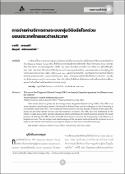บทคัดย่อ
การศึกษานี้เป็นการทบทวนวรรณกรรม มีวัตถุประสงค์เพื่อรวบรวมองค์ความรู้เกี่ยวกับการใช้ระบบกลุ่มวินิจฉัยโรคร่วม (Diagnosis Related Group: DRG) ซึ่งเป็นระบบแบ่งกลุ่มผู้ป่วยแบบเฉียบพลัน พัฒนาโดย Robert Fetter และคณะ ที่มหาวิทยาลัยเยล ประเทศสหรัฐอเมริกา เดิมชื่อ Yale DRG มีการพัฒนาและใช้มาร่วมกว่าสี่ทศวรรษ ผู้ป่วยที่จัดอยู่ในกลุ่ม DRG เดียวกันจะได้รับบริการที่ใช้ทรัพยากรของโรงพยาบาลคล้ายคลึงกัน ยอดจ่ายชดเชยต่อการรักษาผู้ป่วยหนึ่งรายคำนวนจากอัตราจ่ายต่อ DRG (DRG-based rate) คูณค่าน้ำหนักสัมพัทธ์ และปัจจัยตัวประกอบปรับค่าที่ขึ้นกับบริบทของแต่ละประเทศ ระบบการเบิกจ่ายแบบ DRG มีวัตถุประสงค์หลักเพื่อให้เกิดความโปร่งใส และเพิ่มประสิทธิภาพของระบบบริการสาธารณสุข จึงควรมีการศึกษาถึงข้อดีและข้อเสียอย่างรอบด้านเพื่อส่งเสริมส่วนที่ดีและอุดรอยรั่วหรือแก้ไขส่วนที่ส่งผลเสียต่อระบบสาธารณสุข
บทคัดย่อ
This article aimed to gather the knowledge about Diagnosis Related Group (DRG). The DRG is an
acute-inpatient classification system. Developed by Robert Fetter and his colleagues at Yale University, it
was initially called Yale DRG. The system has been used for over four decades. Patients in the same DRG
group are provided similar services and the hospital’s resources. The DRG-base rate multiplied by the
relative weight and country-specific adjustment factors determines the reimbursement amount. The main
purpose of utilizing the DRG system in health financing is to increase the transparency and efficiency of
hospital services. The advantages and disadvantages of the payment method should be explored so as to
improve the system and minimize any negative impacts it may have on health financing.


